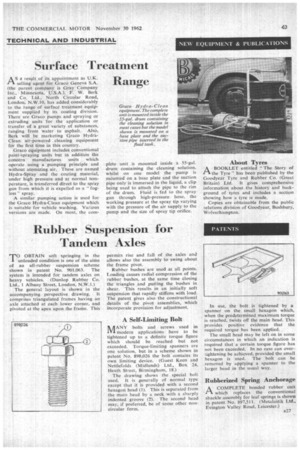Rubber Suspension for Tandem Axles
Page 45

If you've noticed an error in this article please click here to report it so we can fix it.
TO OBTAIN soft springing in the unloaded condition is one of the aims of an all-rubber suspension scheme shown in patent No. 901,063. The system is intended for tandem axles on heavy vehicles. (Dunlop Rubber Co. Ltd., 1 Albany Street, London, N.W.I.)
The general layout is shown in the accompanying perspective drawing. It comprises triangulated frames baying an axle attached at each lower corner, and pivoted at the apex upon the frame. This permits rise and fall of the axles and allows also the assembly to swing about the frame pivot.
Rubber bushes are used at all points. Loading causes radial compression of the rubber bushes, at the same time closing the triangles and putting the bushes in shear. This results in an initially soft suspension that rapidly stiffens with load. The patent gives also the constructional details of the pivot assemblies, which incorporate provision for adjustment.
A Self-Limiting Bolt
IVIANY bolts and screws used in LVI modern applications have to be tightened up to a definite torque figure which should be reached but not exceeded. Torque-limiting spanners are one solution, but in a scheme shown in patent No. 898,026 the bolt contains its own limiting device. (Guest Keen and Nettlefolds (Midlands) Ltd., Box 24, Heath Street, Birmingham, 18.) The drawing shows the special bolt used. It is generally of normal type except that it is provided with a second hexagon head (1). This is separated from the main head by a neck with a sharply indented groove (2). The second head may, if preferred, be of some other noncircular form.
In use, the bolt is tightened by a spanner on the small hexagon which, when the predetermined maximum torque is reached, twists off the main head. This provides positive evidence that the required torque has been applied.
The small head may be left on in some circumstances in which an indication is required that a certain torque figure has not been exceeded. In no case can overtightening be achieved, provided the small hexagon is used. The bolt can be removed by applying a spanner to the larger head in the usual way.
Rubberized Spring Anchorage
A COMPLETE bonded rubber unit in• which replaces the conventional shackle assembly for leaf springs is shown in patent No. 897,511. (MetalaStik Ltd., Evington Valley Road, Leicester.)




































































































